The Industrial Internet of Things (IIoT) and Industry 4.0 are reshaping the factory floor in what industry leaders hail as smart manufacturing. This new framework fills the gaps in factories and supply chains that were previously considered “integrated,” using a greater number of always-on sensors. Embedded in physical assets that communicate both wired and wirelessly with networks, they feed greater intelligence to systems and users, both onsite and remote, for monitoring, control, planning and optimization of manufacturing processes.
The technologies employed include cloud computing, big data analytics, mobile technology and product lifecycle management (PLM) software. The rise in data collection and the ability to manage it now promises synergistic benefits: new levels of workforce efficiency; faster time to market; lower total cost of ownership; greater asset utilization and up time; greater flexibility and waste reduction.
The Big 5
Many of the tools of the smart manufacturing revolution “have been [in existence] for a long time,” says Georg Kube, global vice president at SAP. “However, they were cumbersome, expensive and based on individual hacks.” Now, with communication, cheap low-power computing/sensing and cloud computing are “suddenly evolving rather quickly.”
Kube cites five key elements of connectivity that characterize smart manufacturing:
- shop-floor-to-top-floor vertical integration,
- end-to-end horizontal integration,
- connectivity with suppliers,
- connectivity with supply chain partners,
- and connectivity with consumers.
Source: LNS Research
In collaboration with Festo Didactic and Elster Kromschröder, SAP creates an Open Integrated Factory Showcase. The demo-scale assembly line uses fully automated conveyors, machines and other work cells including an oven, drill and assembly robot configured to produce two completely different products—a remote control, and components for smart meters. It uses SAP software for vertically integrated cloud-based production planning and end-to-end shop-floor manufacturing execution. RFID tags on work pieces wirelessly instruct each machine exactly how to grind or drill as the pieces move down the line. For SAP, such integration enables greater efficiency and data visibility, lower costs through the elimination of line controllers and greater flexibility to rapidly modify production sequences from large to very small lot sizes.
Manufacturing in the Dark
From demo-scale to reality, the prospect of lights-out manufacturing is closer to becoming true. Siemens’ Amberg Electronics Plant in Bavaria ships 15 million SIMATIC programmable controllers a year, one each second that the plant is running. Human hands touch the product only when bare printed circuit boards are placed on the assembly line.
GE’s “Brilliant” Concept
GE started years ago to design smart factories like its new $73 million gas turbine plant in Greenville, South Carolina, slated for completion later this year. Like the SAP demo, GE says the factory “talks to itself” using IIoT technologies. In October, the company announced it will sell a packaged version of its new Brilliant Manufacturing software suite, an upgrade on its Proficy factory automation system to help “customers like Procter & Gamble make things more efficiently.” It includes GE’s new Predix platform for IIoT connectivity, Proficy Historian and SmartSignal analytics. Rockwell Automation Like-minded efforts are proliferating from Rockwell Automation’s Connected Enterprise to Emerson Process Management.
The New ‘Store it All’ Database Infrastructure
Big data–driven analytics is indispensable for optimizing tomorrow’s manufacturing enterprises. Instead of choosing data collection priorities, Rich Carpenter, chief of strategy for GE Intelligent Platforms, advises manufacturers to “collect it all, store it all, and your data analytics will improve over time.” He adds data scientists constantly pore over historical data to find new patterns among assets “we didn’t know existed, and correlating them to events that we want to avoid in order to optimize our processes.” The dataset goes beyond manufacturing equipment to include business, economic and even climate trends that can influence operations.
To glean the benefits of big data analytics, the “bureaucracy” of automation systems will become more “compressed,” says Dan Miklovic, principal analyst with LNS Research.“If you have a sensor that needs to talk to let the ERP system knows what’s being consumed, that message won’t have to pass from sensor to PLC to MES to ERP—the sensor can just publish that information directly,” says Miklovic. “So when a spark plug is installed in an engine in a just-in-time environment, the bar code scans for that plug and the engine are immediately available in the cloud for anybody that needs it.”
Will the smart factory eliminate all labor? For Suzanne Lee, Ph.D., director of strategic marketing with Siemens, “Smart Factory means embracing modernization. The good news is, it doesn’t have to happen all at once. An incremental approach—starting with one line in a factory—is a great way to move forward. The key is to have a long-term migration and innovation program in place when you start.”













